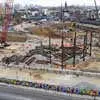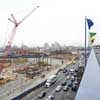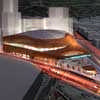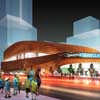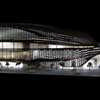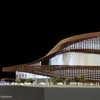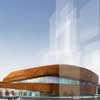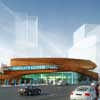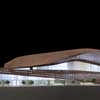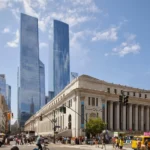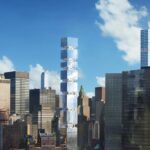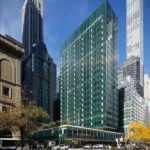Barclays Center Atlantic Yards, Manhattan Building News, Architect, Design
Barclays Center New York : Architecture
Atlantic Yards Development – design by Ellerbe Becket
Nov 23, 2010
Barclays Center – Steelwork Start
STEEL ERECTED AT BARCLAYS CENTER AT ATLANTIC YARDS IN BROOKLYN
WORLD CLASS ARENA ON SCHEDULE TO OPEN SUMMER 2012
(Brooklyn, NY) – November 23, 2010 – The erection of steel began today at the Barclays Center at Atlantic Yards in Brooklyn, Bruce Ratner, Chairman and CEO of Forest City Ratner Companies, the developer of the arena, said today. The first components for vertical construction, including beams, girders and trusses, will be used for the main arena, façade support and the canopy.
“The installation of steel is always a major milestone for a construction project,” said Mr. Ratner. “With the foundation work largely done, we are now poised to go vertical. Over the next several months, the Barclays Center will begin to take on the iconic shape that we believe will make the arena a worldwide destination and Brooklyn an international city.”
“Progress on the Barclays Center spells great things for Brooklyn and its future,” said Brooklyn Borough President Marty Markowitz. “This project will bring jobs, affordable housing and economic opportunity, as well as a triumphant return to major league sports for the greatest fans in the world—Brooklynites.”
Steel erection will begin between the Event and Main Concourse level and progress east in a clockwise direction. Most of the initial activity will be along Atlantic Avenue.
One hundred tons of steel arrived at the site last week. Approximately 10,500 tons of steel will be used for the Barclays Center. The structural steel is being fabricated by Banker Steel Company in Lynchburg, VA. Steel will be erected in the field by J.F. Stearns Company and Ironworkers Local 40 using Liebherr LR 1300 and 1350 crawler cranes.
The Barclays Center is on schedule to open in the summer of 2012.
Barclays Center LEED Certification – 23 Jul 2013
Mar 11, 2010
Barclays Center – Groundbreaking
Groundbreaking at Atlantic Yards
Ceremonial Groundbreaking to Celebrate the Next Phase of Construction
On Atlantic Yards and Sports and Entertainment Arena in Brooklyn : Barclays Center
BARCLAYS CENTER at Atlantic Yards / Brooklyn, NY
ELLERBE BECKET AND SHoP ARCHITECTS TO COLLABORATE
ON BARCLAYS CENTER AT ATLANTIC YARDS
New, Innovative Design to Create Iconic Brooklyn Landmark
(Brooklyn, NY) – September 9, 2009 – Bruce Ratner, the Chairman and CEO of Forest City Ratner Companies (FCRC), the developer of Atlantic Yards in Brooklyn, announced today that the award-winning architectural firms Ellerbe Becket and SHoP Architects will collaborate on the design of the Barclays Center, the new world-class sports and entertainment venue that will serve as the anchor of the planned development and home to the NETS Basketball team.
FCRC also released new design images of the 675,000 square-foot arena, which will be located at the intersection of Atlantic and Flatbush Avenues in Brooklyn. The images can be seen at www.barclayscenter.com. The images and a model will also be available for public viewing at Brooklyn Borough Hall beginning at 10 a.m. on Monday, September 14, 2009.
“The Barclays Center will quickly become an iconic part of the Brooklyn landscape,” said Mr. Ratner. “The design is elegant and intimate and also a bold architectural statement that will nicely complement the surrounding buildings and neighborhoods. The Barclays Center will be innovative in its look and use of materials, including weathered steel and glass, and will be the best place in the world to watch a basketball game and other forms of sports and entertainment.”
Several images were released today that show the Barclays Center from different perspectives, including each major arrival point at the site perimeter. The arena was designed to accommodate other buildings on the arena block that will be part of the Atlantic Yards development, including three mixed-income residential buildings and the commercial building known as B1, along with the Urban Room that will provide access to the Barclays Center.
The building consists of three separate but woven bands. The first engages the ground where the weathered steel exterior rises and lowers to create a sense of visual transparency, transitioning into a grand civic gesture that cantilevers out into a spectacular canopy at the corner of Atlantic and Flatbush Avenues. The canopy, which is 30 feet above ground level, contains an oculus that frames the pedestrian’s view of the arena. The second, a glass band, allows for views from inside and outside of the arena. The third band floats around the roof of the Barclays Center and varies in transparency, the weathered steel creating backlit patterns.
The woven band of the canopy will flow out over the arena entrance, creating a seamless visual transition and helping to frame a large viewing portal into the seating area. The main concourse is placed right at street level, allowing a direct view to and from the street. Large areas of glass at street level make it not only pedestrian-friendly, but also encourage a strong visual connection to the surrounding urban neighborhood.
Construction is expected to begin on the arena later this year, with an anticipated opening during the 2011 – 12 NETS season.
William Crockett, Principal and National Director of Sports Architecture at Ellerbe Becket, which has designed some of the world’s most heralded sports facilities, including the Conseco Fieldhouse in Indiana and the iconic Guangdong Olympic Stadium in Beijing, said, “While the Barclays Center will be the most exciting venue in the country to watch a game, we believe it will also become a destination for people interested in design and the urban environment.
We’ve given special attention to designing what will be the first of an entire new generation of high-performance multi-purpose arenas in the nation. One of the notable assets to the fan experience is the arena’s seating configuration; whether fans attend a NETS game or a concert at the Barclays Center, visitors will have a dramatically intimate view of the action plus a direct visual link of the surrounding neighborhood.”
Gregg Pasquarelli, a Founding Principal at SHoP Architects, the New York based firm that is designing the East River Waterfront at the South Street Seaport and the new Fashion Institute of Technology C2 Building, and is the winner of the 2009 National Design Award for Architecture Design, said, “The design of an arena in an urban context requires a critical balance between an iconic form and the street. It must be legible at multiple scales – on the skyline, from five blocks away, from the plaza and while touching the door. It must also have an identity that delights the occupants, visitors and neighbors.”
Jerry del Missier, President of Barclays Capital, said, “This is a striking contemporary design for the Barclays Center. Barclays is proud to be part of the redevelopment of Brooklyn and of bringing professional sports back to the borough.”
The state-of-the-art facility will have 18,000 seats for basketball and up to 19,000 seats for concerts. There will be 100 luxury suites, including 16 Brownstone Suites (16 seats each), 67 Loft Suites (10 seats each), 11 Courtside Suites, four Club Suites and two Party Suites. The arena will also include 40 loge boxes, six clubs and restaurants, and the Barclays Center Practice Facility on site.
The Barclays Center currently has eight Founding Partners, including ADT, Anheuser-Busch, Cushman & Wakefield, EmblemHealth, MGM Grand at Foxwoods, MetroPCS Communications, Jones Soda Co., and Phillips-Van Heusen. These Partners will be featured prominently in distinct branded “neighborhoods” such as the ADT Plaza, the Cushman & Wakefield Theater, the EmblemHealth Entrance, the IZOD-Nets Team Store, the MGM Grand @ Foxwoods Bar, the MetroPCS Pavilion, and the Jones Soda Shoppe.
In January 2007, Barclays, a leading global financial services company, and the NETS announced a multi-faceted strategic marketing and media partnership that includes a 20-year naming rights of the arena.
About FCRC
Forest City Ratner Companies (FCRC), a wholly owned subsidiary of Forest City Enterprises, owns and operates 30 properties in the New York metropolitan area. Forest City Enterprises, Inc., a $11.7-billion NYSE-listed national real estate company, is principally engaged in the ownership, development, management and acquisition of commercial and residential real estate and land throughout the United States.
About Ellerbe Becket
Ellerbe Becket is internationally recognized as a leader in the architecture, engineering and interior design industries. The firm’s sports practice specializes in the design of “best in class” facilities that are renowned for providing outstanding patron experience AND catalysts for urban redevelopment. Time-tested examples span the country – from Verizon Center in Washington, DC to Qwest Field in Seattle. With offices worldwide, the firm has designed more arenas than nearly any other architectural firm, including 15 new arenas for the NBA and NHL in the past two decades.
Ellerbe Becket brings together fans, athletes, sponsors, and communities through the design of iconic venues that are efficient to build, own and operate. The firm has collaborated with design Architects including Pei Cobb Freed, Wood and Zapata, KCF and Cesar Pelli – and is honored to add SHoP to their list of strategic partners. Ellerbe Becket has designed New York icons including the NY State Psychiatric Research Institute and the SUNY Binghamton Academic Buildings & Research Greenhouse. 2009 marks Ellerbe Becket’s 100th anniversary. For more information, visit www.ellerbebecket.com.
About SHoP Architects
SHoP Architects, a 60 person practice located in downtown Manhattan, founded by its five principals in 1996, has been a leader in the transformation of intricate theoretical design into easily understood construction models by reconsidering architectural practice. This think tank has pushed the designer’s realm past form making and into software design, branding, real estate development, construction, and the co-development of new sustainable technologies.
As both practitioners and educators, their commitment to challenging the entire process of building has proven to a generation of architects that beauty and technological proficiency are not mutually exclusive. Their current work includes a two-mile waterfront park along New York’s East River, and projects for the Fashion Institute of Technology and Goldman Sachs, both in Manhattan, and Google in Mountain View, CA.
Recently completed projects include Garden Street Lofts in Hoboken, NJ, Hangil Book House in Seoul, South Korea, The Porter House in New York City, and SanLiTun in Beijing. SHoP’s work has won numerous awards, including the 2009 National Design Award for Architecture Design, awarded by Smithsonian’s Cooper-Hewitt, National Design Museum. SHoP’s work has also been published and exhibited internationally, and is in the permanent collection of the Museum of Modern Art.
Barclays Center
The design of the Barclays Center achieves a striking balance between iconic form and performative engagement with the street. It is legible at multiple scales; on the skyline, from 5 blocks away, standing on the plaza and touching the front door, while maintaining an identity that delights visitors, neighbors, fans, and spectators.
Site Context and Development
Integrated into one of the busiest urban intersections in the New York metro area, Barclays Center will sustain a healthy, interactive dialogue with the surrounding streets and neighborhood. The Main Public Concourse is placed directly at sidewalk level – and predominately glazed where it meets the sidewalks to ensure direct accessibility and clear visibility in and out of the building.
The Main Public Entrance plaza links Atlantic and Flatbush Avenues and creates a flexible, welcoming yet grand Civic Space for use of the community and building occupants alike. Views and physical access both into and out of the arena will be plentiful, easy and accommodating and thus ensuring a strong connection to the surrounding urban environment. Functional spaces of the Arena are carefully deployed to provide activities and interaction 365 days a year – whether or not a major event is taking place in the building.
The master plan objectives and principles of the Atlantic Yards Development are fully achieved through the proposed integration of the Arena and all access elements on this site.
Exterior Expression and Vision
The overall vision for the exterior composition was to express the horizontality of the arena through the articulation of three bands. The first engages the ground plane where the weathered steel skin and void spaces float in front of the building, raising and lowering themselves to allow as much visual transparency inside as possible.
This lower band also smoothly transitions into a grand civic gesture when it cantilevers out to make a spectacular canopy at the plaza at the corner of Atlantic and Flatbush Avenues. More than 30 feet in the air, the canopy contains an oculus that frames the pedestrian’s view of the arena when exiting the transit hub and approaching the main entrance.
The second horizontal band is predominantly glass, dividing the upper and lower solid bands and allowing views from inside and outside of the structure. The third band floats around the roof of the arena and varies in its transparency as the weathered steel scrim creates backlit patterns around the ‘halo.’
During the day the void patterns on the skin allow light inside to expose the lace like structure within. At night the skin is softly back lit, reversing the patterns while direct views into the seating bowl and the scoreboards are allowed. The effect is a structure whose scale is mitigated yet still holds a presence as an iconic, sculptural, piece of architecture.
Interior Planning and Key Features
The multi-story main public lobby is entered by passing through a transparent glass curtain wall engaging the vibrant urban plaza. A large view portal between this entry space and the arena seating area allows views into the seating bowl from the plaza and Flatbush Avenue – and vice versa. The entire entry sequence has been carefully choreographed so as to give visitors orientation clues and heighten their sense of anticipation.
In addition, visitors entering the lobby can directly access the main box office and the Nets team store, as well as find a view to the practice court that is one level below grade. This view in to the Nets practice facility will be available to passers-by on Atlantic Avenue as well. The Barclays Center concourses are designed to be wide, graciously active and accommodating with well distributed food and beverage locations. All restrooms are strategically located and designed to be easy to find, are fully ADA compliant and are sized to accommodate internal queuing.
Prominent, active retail spaces are integrated into the main public concourse so as to contribute to the street life and activate the internal space. Ticketholders to the Barclays Center seating will experience one of the most intimate seating configurations yet designed into a modern multi-purpose arena.
All seating types, from the most affordable to the most exclusive, have been designed with into the arena with the goal of all having the best view to the floor as possible – conveying a sense of being “right on top of the action”. Barclays Center, in addition to being the home to the NBA Nets, will host a large variety of events throughout the year. From top name musical concerts, to family shows and community programs, the arena will be a hub of activity around the clock.
To effectively manage the operations of this complex building type, all loading for events will be below grade and enclosed within the arena envelope. Additionally, access to the secure subterranean loading dock area will be via a specially designed semi-truck elevator that will ensure minimal impact to the street level environment. Design
The Nets
In 2004 Forest City Ratner Companies led an investment team that successfully bid for the New Jersey Nets. The goal is for the team to begin playing in Brooklyn in the 2011-2012 NBA season. Forest City Ratner Companies (FCRC) is building Atlantic Yards, a development that includes a sports and entertainment arena called the Barclays Center designed by the award-winning architectural firms SHoP Architects and Ellerbe Becket, mixed-income housing, a boutique hotel, commercial and retail space, as well as 8 acres of publicly accessible open space.
The Project
Atlantic Yards involves the redevelopment of 22 acres in downtown Brooklyn that will include approximately 6 million square feet of residential space (6,430 units of affordable and market-rate housing), an 18,000 seat sports and entertainment arena, 247,000 square feet of retail use, approximately 336,000 square feet of office space and 8 acres of publicly accessible open space. The Design Guidelines that govern the entire project are based on a Master Plan designed by renowned architect Frank Gehry.
The Location
The development will be located at Atlantic and Flatbush Avenues, bounded by Pacific and Dean Streets and Vanderbilt Avenue, primarily situated over the MTA/LIRR’s Vanderbilt Yards. Atlantic Yards will be adjacent to New York’s third largest subway hub with 10 subway lines and the LIRR, providing easy access from all five boroughs and Long Island.
Project Size
The Atlantic Yards project will include an arena and 16 new buildings to be utilized for residential, office and retail purposes. The height of the buildings will range from approximately 190 feet to 511 feet. The residential building street walls located on Dean Street between Vanderbilt and Carlton Avenues will range between 50 and 90 feet (or five to nine stories), with setbacks to the north of at least 60 to 70 feet. Building 1, the building that will eventually be built at the corner of Flatbush and Atlantic Avenues, is anticipated to be no taller than the Williamsburg Savings Bank which stands at 512 feet.
Economic Benefits
Atlantic Yards will be an economic engine for Brooklyn, New York City and the State generating over $5.6 billion in new tax revenues over the next 30 years and creating a net positive fiscal impact of more than $1.3 billion. In addition to tax benefits, the project will also create thousands of new jobs: upwards of 17,000 union construction jobs and over 8,000 permanent jobs.
Affordable Housing
Of the 6,430 units of housing, 4,500 will be rental apartments and the rest will be market rate condos. Working with ACORN, FCRC has committed to an affordable housing model that sets aside 2,250 rental units for a combination of low-, moderate- and middle-income families. In addition, 10% of the rental units will be for senior citizens.
In addition to the 2,250 affordable and middle-income rental units, Forest City Ratner has agreed with ACORN to build between 600-1,000 affordable homeownership units. FCRC will seek to build at least 200 of these affordable home-owner units on site (they will be part of the proposed 6,430 units of housing already approved as part of the Atlantic Yards FEIS/GPP). FCRC will also seek to build the remaining affordable home-owner units as close to Atlantic Yards as possible.
Community Benefits Agreement (CBA)
FCRC entered into a historic and unprecedented Community Benefits Agreement, the first of its kind in New York, on June 27, 2005. This voluntary and legally binding agreement with the community focuses on delivering job training, jobs, affordable housing, small business and MWBE development and other community amenities and facilities for community residents.
For example, FCRC has agreed to continue its longstanding commitment to minority and women owned businesses, by ensuring that at least 30% of contracts and 45% of all construction jobs are to be held by women and minorities. FCRC will also provide for the development of schools, a day care, youth and senior facility, as well as a state-of-the-art health care facility to provide high tech health services not available in the local community. And as noted above, FCRC has agreed to work with ACORN to develop an unprecedented housing plan for low-income and working families.
Community Involvement
FCRC continues to work with a wide array of diverse community based organizations, ministers and churches across the borough. Our CBA partners include: ACORN, Brooklyn United for Innovative Local Development (BUILD), the Faith In Action, the Downtown Brooklyn Neighborhood Alliance (DBNA), the New York State Association of Minority Contractors (NYSAMC), Public Housing Communities (PHC), the Brooklyn Voices for Children (BVC) and the Brooklyn Endeavor Experience (BEE).
Eminent Domain
While much of the 22 acre project site is made up a LIRR storage facility, the remainder comprises of empty lots, gas stations, auto repair shops, underutilized or vacant industrial and manufacturing buildings and some residential buildings. In 2005, FCRC promised to substantially reduce the need for eminent domain and has lived up to that promise by acquiring much of the property needed to complete the project and now owns or controls 85% of the land needed to complete the project.
FCRC has also agreed to a tenant relocation program where assistance will be provided to residential tenants who may be displaced by the project. Such tenants have been and will continue to be offered a residence to stay during construction and a unit in the new development at the same rent they pay today.
Sustainability
Atlantic Yards is committed to achieving LEED (Leadership in Energy and Environmental Design) certification for all 16 buildings and the Arena. Now that construction has begun, environmental quality-of-life measures are in place, including use of Ultra Low Sulfur Diesel Fuel, diesel particulate filters installed on on-site equipment with 50 hp or greater, best available and most efficient equipment, dust suppression, restrictions on idle time for vehicles and the use of locally manufactured materials when possible is underway.
Demolition and construction waste is another priority, and of the buildings that have been demolished so far, at least 75% of the materials have been recycled (with a building high of 97%), thereby diverting 467 tons of materials from landfills.
The project will promote the use of bicycles by providing a 400 bicycle storage station for use by residents and local commuters. Storm-water management is a significant part of this plan; once completed, Atlantic Yards will reduce the volume of combined sewer overflow that currently flows into the Gowanus Canal by more than 2 million gallons per year by retaining rainwater and reusing it.
Atlantic Yards’ plan calls for a $50 million clean up of the existing environmentally damaged site and transforming it into 8 acres of open public space, environmentally sustainable buildings, while reducing sewage overflows and creating a LEED certified sports arena.
Construction on Site
Construction work on Atlantic Yards began in February of 2007. We expect the Barclays Center to open in the 2011-2012 basketball season.
• To date 35 buildings, roughly 56% of the structures on the site have been demolished. There are 11 vacant lots and 29 other remaining structures. FCRC owns or controls approximately 85% of the site.
• Over $45 million worth of contracts have already been awarded to contractors for work on the site thus far.
• Of that $45 million total, Minority-and Women-Owned Business Enterprises (MWBE) have been awarded 44.2 percent of the contracts for Atlantic Yards.
• Construction of the temporary rail yard and critical upgrades to the sewer and water infrastructure in the area are underway.
Barclays Center New York information received 090909
Atlantic Yards Barclays Center New York
14 Aug 2012
Barclays Center Review
Billion Dollar Anaconda
Article by Dimple Soni – “Ever seen a sports arena guarded by a giant Anaconda? In the Brooklyn borough of New York City, the neighborhoods of Boerum Hill, Fort Greene, Park Slope and Prospect Heights have new company in their vicinity – a giant cuddle-up Anaconda. Its bold presence has impregnated the air with fear, inhibition and much excitement. A major transformation of the neighborhoods is in process, which would be exponential once the Anaconda is awake”.
Read more at Barclays Center Brooklyn
Barclays Center Designers
Ellerbe Becket and SHoP Architects
Atlantic Yards Development Masterplan – previous architect : Frank Gehry
Location: Barclays Center, New York City, USA
New York City Architecture
Contemporary New York Buildings
NYC Architecture Designs – chronological list
New York City Architecture Tours by e-architect
New York State Architecture Designs
Comments / photos for the Barclays Center Atlantic Yards – Brooklyn Architecture page welcome

